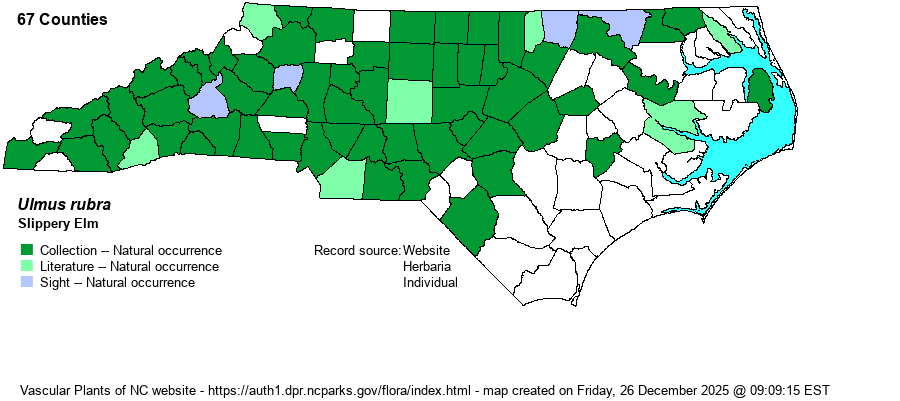| Author | Muhlenberg | |
| Distribution | Occurs over all of the Piedmont, and most of the Mountains; widely scattered in the northern half of the Coastal Plain, but mostly near the Roanoke River and the VA state line. Absent from the Sandhills, nearly all of the southern Coastal Plain, most far eastern counties, and most of the northern Mountain counties.
This is a widespread Eastern species, though it does not range as far south as American Elm (U. americana). It occurs south only to northern FL and to central TX. | |
| Abundance | Infrequent to fairly common in the Piedmont and the central and southern Mountains, being most numerous (fairly common) in the southern Mountains and southwestern Piedmont. Rare to locally uncommon in the Coastal Plain, and essentially only along brownwater rivers (mostly the Roanoke, Neuse, and Cape Fear) and other areas of high pH soils. Absent in the Sandhills proper. | |
| Habitat | This is a species that is restricted to rich, and often high pH, soils. It favors moist hardwood slopes over mafic rocks (in Basic Mesic Forest, for example), but it is also found in cove forests and in somewhat drier forests but always where the soil is dark brown and circumneutral or basic. It can also be found in some brownwater bottomlands, where care should be taken to separate it from American Elm. It may also be seen along forested margins, as long as the soil is circumneutral. |
| Phenology | Flowers from February to April, and fruits from March to May. | |
| Identification | This is a small to medium deciduous tree, growing elsewhere to 60-80 feet tall, but in NC it usually grows to about 50 feet tall. Less familiar to most people than American and Winged (U. alata) elms, it nonetheless is not hard to find in much of the Piedmont and the southern half of the mountains. Normally, one identifies it (and American Elm) by the rather large elliptic leaves that are strongly serrate on the margins, have an uneven leaf base (wider on one side than the other), strongly parallel veins, and an acuminate tip. The leaves average larger than American Elm, being 4-5 inches long, and are very scabrous above, easily noted by running your finger across the upper surface. The leaves tend to be somewhat paler green above than those of American Elm, especially when growing in the sun. The fruit also are different, being flattened but almost rounded, much wider than those of American Elm. | |
| Taxonomic Comments | None
| |
| Other Common Name(s) | Red Elm | |
| State Rank | S5 | |
| Global Rank | G5 | |
| State Status | | |
| US Status | | |
| USACE-agcp | FAC link |
| USACE-emp | FAC link |

